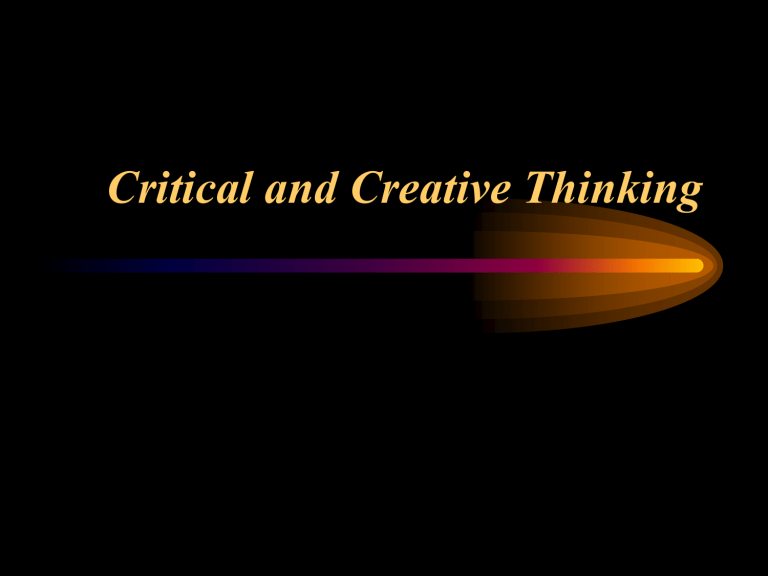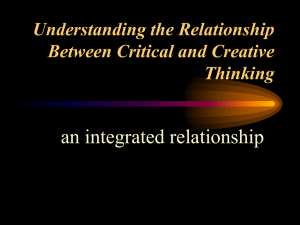
Critical and Creative Thinking “The critical & creative functions of the mind are so interwoven That neither can be separated from the other without an essential loss to both.” anonymous In Webster’s Dictionary of Synonyms “The word ‘critical’ when applied to persons who judge and to their judgments, not only may, but in very precise use does, imply an effort to see a thing clearly and truly so that not only the good in it may be distinguished from the bad and the perfect from the imperfect, but also that it as a whole may be fairly judged and valued.” In Webster’s New World Dictionary, the word ‘creative’ has three interrelated meanings: 1. Creating or able to create, 2. Having or showing imagination or artistic or intellectual inventiveness 3. Stimulating the imagination and inventive powers Criticality assesses; creativity originates Critical and creative thought are both achievements of thought. Creativity masters a process of making or producing Criticality masters a process of assessing or judging Intellectual discipline and rigor are at home with originality and productivity In critical thinking we assess thinking to make improvements. In creative thinking we generate thinking based on our sense of how to make things better. Thus critical thinking has a creative component: to produce a better product of thought And creative thinking has a critical component: to reshape thinking in keeping with criteria of excellence. Critical thinking without a creative output is merely negative thinking. Creative thinking without a critical component is merely novel thinking. It is easy to be merely negative or novel in one’s thought. Achieving quality requires standards of quality---and hence criticality Achieving useful produces of one’s thinking requires a sense of how to make, or recast, one’s thinking at a higher level. To achieve any challenging end, we must have: criteria, gauges, measures, models, principles, standards, or tests to use in judging whether we are approaching that end. We don’t achieve excellence in thinking with no end in view. We design for a reason With standards that enable us to generate a product that meets crucial criteria. Our creative thinking must be tested against critical standards. The generative power of our thought represents its creativity • The judiciousness of our thought represents its criticality. • Generativeness must be married to judiciousness to achieve excellence. Every genuine act of figuring out anything is a new making, a new series of creative acts, however mundane. To come to understand anything requires that the mind construct new connections in the mind. No one can be given knowledge or understanding; they must all create or construct it for themselves. Didactic teaching does not work because it violates the essential conditions under which the mind learns---by acts of construction in the mind. At even the most fundamental level of learning, at the earliest age of learning, the learner must actively construct (create) to learn. We must abandon the notion that knowledge can be “transmitted” without active creative construction on the part of the learner. At even the most fundamental level of learning, at the earliest age of learning, the learner must actively assess its construction to take genuine ownership. Am I being clear? Am I being accurate? These are minimal criteria for the construction of knowledge. The essential need for criticality and creativity applies to the work of the most humble student as well as that of the greatest genius If we study the development of the greatest minds--Aristotle, Beethoven, Curie, Da Vinci, Galileo, Michelangelo, Newton, Darwin, Einstein---we will discover that each went through a period of growth in which they internalized high standards of criticality that played a significant role in the manner in which they went about their later creative production. A Necessary Condition to the Development of Critical and Creative Thinking is: A Questioning Mind Understanding the Mind of Isaac Newton At the age of 19 Newton drew up a list of questions under 45 headings. His title, Quaestiones, signaled his goal: to constantly question the nature of matter, place, time, and motion. He worked hard to understand the thinking of others working on his list of problems. For example, he bought Dascartes’s Geometry and read it by himself. After two or three pages, when he could understand no further, “he began again and advanced farther and continued doing so till he made himself master of the whole.” Understanding the Mind of Charles Darwin Like Newton (and Einstein) Darwin had a careful mind rather than a quick one: “I have as much difficulty as ever in expressing myself clearly and concisely; and this difficulty has caused me a very great loss of time, but it had had the compensating advantage of forcing me to think long and intently about every sentence, and thus I have been lead to see errors in reasoning and in my own observations or those of others.” Understanding the Mind of Albert Einstein Einstein failed his entrance exam to Zurich Polytechnic. When he finally passed (by attending a cram school) he did not want to think about scientific problems for a year. His final exam was so non-distinguished that afterward he was refused a post as an assistant. Understanding the Mundane Nature of Critical and Creative Thinking Creativity should not be mystified. Much of what appears to be inexplicable can be explained by mundane accounts. The great creative thinkers were great critical thinkers, and vice versa. The interrelation and interdependence holds for all learners and thinkers at all levels. Stimulating intellectual work develops the intellect as both creator and evaluator: as a creator that evaluates and as an evaluator that creates. The result is fitness of mind, comprehensive intellectual excellence.


